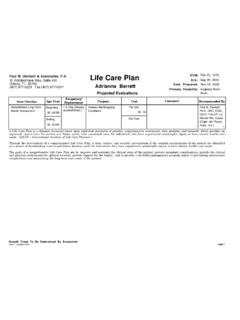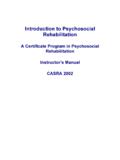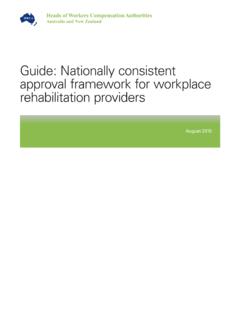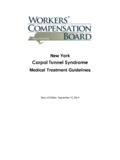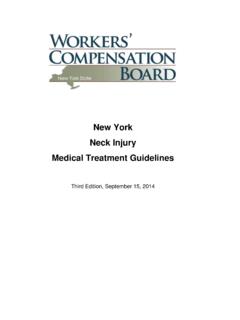Transcription of Paul M. Deutsch & Associates, P.A. Life Care Plan DOB
1 Robert GabrielProjected EvaluationsLife Care Plan Item / ServiceAge YearPurposeCostRecommended ByCommentFrequency/ReplacementDOB:Feb 3, 1952 Oct 22, 2007 Mar 17, 2008 Bilateral LowerExtremity AmputationsD/A:Primary Disability:Date Prepared: paul M. Deutsch & Associates, Windsormere Way, Suite 400 Oviedo, FL 32765(407) 977-3223 Fax (407) 977-0311 Rehabilitation /Long-Term NeedsAssessmentAssess HandicappingConditions.$0 - $0 Per YearPaul M. Deutsch , , CRC, CCM,CLCP, FIALCP Hlth. Couns.(Chptr. 491 Act.)EndingBeginningPer UnitA Life Care Plan is a dynamic document based upon published standards of practice, comprehensive assessment, data analysis, and research, which provides anorganized, concise plan for current and future needs, with associated costs, for individuals who have experienced catastrophic injury or have chronic health careneeds. (IALCP - International Academy of Life Care Planners, 2003.)Through the development of a comprehensive Life Care Plan, a clear, concise, and sensible presentation of the complex requirements of the patient are identifiedas a means of documenting current and future medical needs for individuals who have experienced catastrophic injury or have chronic health care goals of a comprehensive Life Care Plan are to: improve and maintain the clinical state of the patient; prevent secondary complications; provide the clinicaland physical environment for optimal recovery; provide support for the family; and to provide a disability management program aimed at preventing unnecessarycomplications and minimizing the long-term care needs of the X Only (Alreadyaccomplished.)
2 155 1/17/0855 1/17/08 Growth Trend To Be Determined By Economist. Table 2 Copyright 1 Robert GabrielProjected EvaluationsLife Care Plan Item / ServiceAge YearPurposeCostRecommended ByCommentFrequency/ReplacementDOB:Feb 3, 1952 Oct 22, 2007 Mar 17, 2008 Bilateral LowerExtremity AmputationsD/A:Primary Disability:Date Prepared: paul M. Deutsch & Associates, Windsormere Way, Suite 400 Oviedo, FL 32765(407) 977-3223 Fax (407) 977-0311 PsychologicalEvaluate needs,formulate treatment planand modify treatment planas needed.$280 - $336 Per YearPaul M. Deutsch , , CRC, CCM,CLCP, FIALCP Hlth. Couns.(Chptr. 491 Act.)EndingUnit cost reflects a two hour UnitPsychological Adjustment of Adult Amputees: Amputees have to make permanent behavioral, social, and emotional adjustments to cope with the multipleproblems engendered by amputation. As amputees begin to regain strength and develop some security in coping on a physical level, their focus shifts to learninghow to survive emotionally with limb loss.
3 Not only have they sustained a loss in ability and function, but they have also sustained a loss to their psychologicalbeing. It is widely recognized that amputees frequently manifest a pattern of emotional reaction involving shock, denial, grief, anxiety, depression, and,eventually, adjustment. Rates of clinical depression detected in outpatient settings have been found to range from 21% to 35% in four studies employingstandardized self-report measures. Reactions of anxiety and grief among people with amputations have also been reported. Although many amputees adjust wellto their prosthesis, some amputees experience emotional maladjustment or pain and may need something more than a well-fitting limb and training in its to the loss of a limb is a multifaceted endeavor that involves both physical and psychological adjustment. Source: Gallagher, Pamela, Dr.; Departmentof Psychology at Trinity College, Dublin, Ireland. Psychological Adjustment and Coping in Adults with Prosthetic Limbs Statistical Data Included.
4 Copyright1999 Heldref Publications; Copyright 2000 Gale Group. issues in the Field of prosthetics and orthotics: Rehabilitation after amputation is fundamentally dependent on the patient s psychologicaladjustment to the injury. Difficulties in adjustment are typically associated with reports of depression, feelings of hopelessness, low self-esteem, fatigue, anxiety,and sometimes suicidal ideation. Therefore, specific, structured therapeutic interventions for problems such a depression, anxiety, sexual difficulties, substanceaddiction or drug overuse and pain may be needed. Such intervention may operate through individual, couple, family or group therapies. Source: Desmond,Deirdre, BA (Mod); MacLachlan, Malcolm, BSc, MSc, MA, PhD, DipVus, FPSI, FTD. Psychosocial Issues in the Field of Prosthetics and Orthotics. Journal ofProsthetics & Orthotics; 2002, Volume 14, Number 1, pp. 19-22. specialties involved in caring for amputees include physiatry, surgery, medicine, physical therapy, occupational therapy, nursing, mental health, socialworks and prosthetics.
5 This type of teamwork has shown to improve short and long-term outcomes. Additionally, incorporating peer support, vocationalrehabilitation, community reintegration and sports and recreational activities greatly enhances a comprehensive program and improves amputees' quality of lifeand ability to reintegrate into the community. Source: Pasquina, paul F. MD; Bryant, Phillip R. DO; Huang, Mark E. MD; Roberts, Toni L. DO; Nelson, VirginiaS. MD, MPH; Flood, Katherine M. MD. Limb Deficiency And Prosthetic Management: Focused Review. Advances in Amputee Care. Archives of Physical Medicineand Rehabilitation, Volume 87, Supplement 1, March 2006, pp. S34 - X / 2-4 Years256 2008 Life Trend To Be Determined By Economist. Table 2 Copyright 2 Robert GabrielProjected EvaluationsLife Care Plan Item / ServiceAge YearPurposeCostRecommended ByCommentFrequency/ReplacementDOB:Feb 3, 1952 Oct 22, 2007 Mar 17, 2008 Bilateral LowerExtremity AmputationsD/A:Primary Disability:Date Prepared: paul M.
6 Deutsch & Associates, Windsormere Way, Suite 400 Oviedo, FL 32765(407) 977-3223 Fax (407) 977-0311 Physical TherapyEvaluate therapy needs;design and monitortherapy program andprovide home exercisesto continue to buildstrength and endurance.$209 - $323 Per YearF. Parker Loren, $418 - $646 / year for 2 years; then$209 - $323 / year UnitCritical specialties involved in caring for amputees include physiatry, surgery, medicine, physical therapy, occupational therapy, nursing, mental health, socialworks and prosthetics. This type of teamwork has shown to improve short and long-term outcomes. Additionally, incorporating peer support, vocationalrehabilitation, community reintegration and sports and recreational activities greatly enhances a comprehensive program and improves amputees' quality of lifeand ability to reintegrate into the community. Source: Pasquina, paul F. MD; Bryant, Phillip R. DO; Huang, Mark E. MD; Roberts, Toni L. DO; Nelson, VirginiaS. MD, MPH; Flood, Katherine M.
7 MD. Limb Deficiency And Prosthetic Management: Focused Review. Advances in Amputee Care. Archives of Physical Medicineand Rehabilitation, Volume 87, Supplement 1, March 2006, pp. S34 - Therapy for Amputations: Over the course of 6 months, patients will demonstrate optimal motor function; muscle performance; range of motion andgait, locomotion and balance; and the highest level of functioning in home, work, community and leisure environments. 80% of patients will achieve theanticipated goals and expected outcomes within 15 to 45 visits during a single continuous episode of care. Some risk factors or consequences of pathology /pathophysiology such as multisystem involvement and traumatic amputation of multiple parts may be severe and complex and may require modification of thefrequency of visits and duration of care. Source: Second edition 2001, 2003 by the American Physical Therapy Association (APTA). (Guide to Physical TherapistPractice. 2nd ed. Impaired Motor Function, Muscle Performance, Range of Motion, Gait, Locomotion, and Balance Associated With Amputation, Section 4J; pp.)
8 287-303.)2 X / Year for 2years; then 1 X /year 2008 Life TherapyAssess therapy needs,formulate home exerciseprogram, etc.$209 - $323$209 - $323 Per YearF. Parker Loren, UnitCritical specialties involved in caring for amputees include physiatry, surgery, medicine, physical therapy, occupational therapy, nursing, mental health, socialworks and prosthetics. This type of teamwork has shown to improve short and long-term outcomes. Additionally, incorporating peer support, vocationalrehabilitation, community reintegration and sports and recreational activities greatly enhances a comprehensive program and improves amputees' quality of lifeand ability to reintegrate into the community. Source: Pasquina, paul F. MD; Bryant, Phillip R. DO; Huang, Mark E. MD; Roberts, Toni L. DO; Nelson, VirginiaS. MD, MPH; Flood, Katherine M. MD. Limb Deficiency And Prosthetic Management: Focused Review. Advances in Amputee Care. Archives of Physical Medicineand Rehabilitation, Volume 87, Supplement 1, March 2006, pp.
9 S34 - X / Year456 2008 Life Trend To Be Determined By Economist. Table 2 Copyright 3 Robert GabrielProjected EvaluationsLife Care Plan Item / ServiceAge YearPurposeCostRecommended ByCommentFrequency/ReplacementDOB:Feb 3, 1952 Oct 22, 2007 Mar 17, 2008 Bilateral LowerExtremity AmputationsD/A:Primary Disability:Date Prepared: paul M. Deutsch & Associates, Windsormere Way, Suite 400 Oviedo, FL 32765(407) 977-3223 Fax (407) 977-0311 Assistive TechnologyEvaluationEvaluate environmentand needs for assistivetechnology to enhancehis independence.$250 - $350 Per YearF. Parker Loren, and ErnieClements,ProsthetistEndingBeginning Per UnitAssistive Technology assessment and evaluation providers are most often licensed and or certified in related fields such as Physical Therapy, OccupationalTherapy, and Speech/Language Pathology. Rehabilitation Engineers, while not certified/licensed, have engineering or technology backgrounds. OccupationalTherapists are professionals who have training and expertise in clinically recognized areas.
10 All practicing therapists must pass standardized tests and be certifiedor licensed in their field. Qualified therapists have a working knowledge of assistive technology foundations, devices, and applications, and can complete a formalAT assessment which may be required by your funding source. Standards for formal AT assessments vary, but a good assessment should verify a need for assistivetechnology and verify that the recommended AT will meet that need. Source; TechACCESS Home Page. What is an Assistive Technology Assessment? X / 2-3 Years556 2008 Life TherapyAssess leisure interestsand recommend adaptiveequipment.$400 - $600 Per YearPaul M. Deutsch , , CRC, CCM,CLCP, FIALCP based on medicalinformation andclient interviewEndingCost includes start up equipment andsupplies. Periodic evaluationsnecessary to accommodate for UnitCritical specialties involved in caring for amputees include physiatry, surgery, medicine, physical therapy, occupational therapy, nursing, mental health, socialworks and prosthetics.



